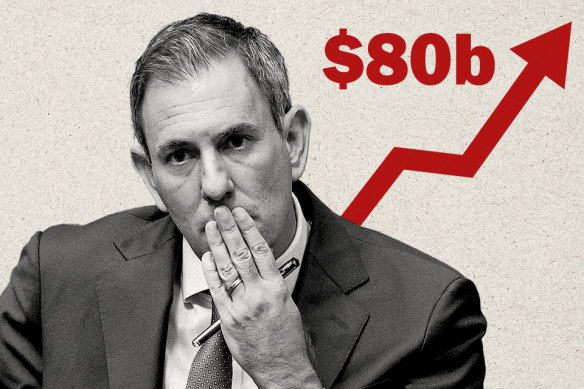Save articles for later
Add articles to your saved list and come back to them any time.
Higher interest rates are hitting the federal budget as well as household spending, and are forecast to cost the government an extra $80 billion over 11 years in larger interest repayments on debt bills.
Borrowing costs will overtake the NDIS as the fastest-growing area of federal government spending, according to figures from the mid-year budget update, even as gross Commonwealth debt is projected to be lower than forecast in the May budget.
Treasurer Jim Chalmers says higher interest rates mean government debt is more expensive to service.Credit: Aresna Villanueva
The government has been under pressure to do more in Wednesday’s update to put downward pressure on inflation and also help struggling Australians as cost-of-living pressures continue to strain household budgets.
Treasurer Jim Chalmers, who has repeatedly said the budget update will not contain major new spending initiatives, said there were still major pressures on the government’s finances, including higher interest rates.
“But by getting the debt down from what we inherited, we will save the Australian people tens of billions of dollars in interest costs to service that debt. That means we can have a much stronger bottom line and we can also invest in other priorities,” he said in Brisbane on Sunday.
“The mid-year update will show really welcome, really encouraging, really substantial progress when it comes to getting the budget in much better nick. It will also show that we’ve made room for key investments in housing, in Medicare, in energy, in skills, in all of the ways that we are strengthening our economy.”
Following the recent release of national economic figures which showed households had dramatically reduced their saving as their real spending power continued to fall, shadow treasurer Angus Taylor said the government has failed to prioritise fighting inflation, making the budget sustainable and growing the economy.
The treasurer said the government has been working to repair the federal budget responsibly, but Wednesday’s mid-year economic outlook will show higher interest rates are hurting the Commonwealth’s balance sheet as well as that of ordinary households.
“The interest bill on the Coalition’s wasted decade is now the fastest-growing expense in the budget,” he said.
“We’re getting government debt on a better trajectory, but that debt is becoming more expensive to service.”
Since May last year the Reserve Bank has rapidly lifted interest rates from 0.1 per cent to 4.35 per cent as it fights high inflation, which has fallen from a peak of about 8 per cent late last year to 4.9 per cent in October, according to the monthly figures.
While inflation helped deliver a budget surplus for 2022-23, the higher interest rates have forced Treasury to recalculate the average cost of new borrowing. Treasury now assumes interest rates will be on average 4.7 per cent, up from 3.4 per cent in the May budget.
That updated calculation means the government is expected to pay an additional $80 billion in interest through to the end of 2033-34.
Borrowing costs are now forecast to grow by 11.7 per cent through this financial year, higher than the projected 10.1 per cent spending growth for the NDIS. Hospital spending is forecast to grow by 6.5 per cent, followed by Defence (6.3 per cent) and medical benefits (5.9 per cent).
The increase in interest bills comes even as gross government debt is now no longer projected to reach $1 trillion this financial year.
Treasury forecasts gross debt for 2023-24 will be $147 billion lower, reaching $909 billion by the end of the financial year, or 34.7 per cent of Australia’s local economic output (GDP).
But the higher borrowing costs mean gross debt will also peak later, and is expected to reach 35.4 per cent of GDP by 2027-28.
Start the day with a summary of the day’s most important and interesting stories, analysis and insights. Sign up for our Morning Edition newsletter.
Most Viewed in Politics
From our partners
Source: Read Full Article

